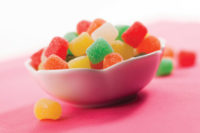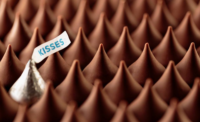
By Deborah Cassell
You don’t have to be a scientist to enjoy experimentation. When it comes to food and beverage, including chocolate, the American consumer is open to new flavors and formats.
“The U.S. chocolate market is a mature, differentiated and exacting market,” according to “The U.S. Market for Chocolate 2010,” a Packaged Facts report due out this August. In it, Senior Analyst Curtis Vreeland writes that chocolate innovations are influenced by “rapidly changing product trends in other beverage and food sectors,” such as super fruits, functional ingredients and savory or ethnic flavors.
Chocolatiers are “experimenting with adding kitchen cabinet ingredients such as olive oil, bacon, cheese, curry and chipotle into their bonbons and truffles,” Vreeland says, adding that “bacon and chocolate, a great riff on sweet and savory, is one popular savory flavor combination with strong market legs.”
In total, “launches of savory-inspired chocolates increased at an 18% CAGR for a five-year period ending in 2008, according to Packaged Facts estimates based on Product Launch Analytics data from Datamonitor,” the report states, and sweet/savory combinations continue to spur new product development.
In addition, “consumers are becoming much more sophisticated about the content and character of their chocolate,” Vreeland points out. For example, micro-roasting and selecting “fine flavor beans from specific estates and vintages” are types of creativity that help “create specialized segments and niches catering to a wide spectrum of consumer tastes and budgets.”
In general, the premium segment “thrives on dark chocolate, single origins and inclusions of healthy ingredients,” Vreeland continues. “Product claims usually note natural ingredients and, to an increasing degree, ethical certification.” High-end presentations made through the use of moulds and texture changes such as matted surfaces, engraved tablets or bars imprinted with logos are additional premium calling cards to date.

Form & Function
In mainstream markets, large bars or tablets are a widely recognized format for premium chocolate.Among the most well-known brands is Lindt, which has been making chocolate for 165 years and produces the iconicLindor Truffle. Lindt also boasts a full line ofExcellencebars in varieties ranging from 50% to 90% Cocoa to Chili, Mint, White Coconut and two new flavors: Roasted Almond (a combination of premium dark chocolate and crunchy, slivered almonds) and Black Currant (premium dark chocolate accompanied by tart black currants and crunchy, slivered almonds).
The bars have “a thin, refined profile to offer chocolate lovers a unique and sophisticated experience as the chocolate melts evenly in their mouth,” notes Tami Luongo, brand manager of bars at Lindt USA.
Then there’s Ghirardelli, “America’s longest continuously operating chocolate manufacturer,” describes
Marketing Vice President Mona Maher, adding that the manufacturer is one of just a few to produce chocolate starting from the cocoa bean through to finished products. “Throughout the process, we take special steps to ensure that our premium chocolate delivers our signature intense, smooth-melting chocolate taste. We call this ‘The Ghirardelli Difference.’”
Ghirardelli’sLUXE MILK chocolate bars, launched last year, feature all-natural ingredients and come in five flavors: Almond, Hazelnut, Milk, Crisp and the latest addition, Toffee. The brand also offers Milk Chocolate & Caramel LatteSQUARES: espresso-infused caramel surrounded by intense, creamy milk chocolate. Furthermore, the company has introduced a 1.15-oz. premium bar for consumers on-the-go. Currently available in Milk Chocolate with Caramel Filling, Ghirardelli’s most popular flavor, the bar breaks into three bite-sized squares.
Godiva is yet another name that resonates with consumers of premium chocolate. The company’s Large Bar platform has expanded to include “five decadent chocolate bars in varying cocoa percentages to match the experience that consumers crave,” notes Lauri Kien Kotcher, cmo and senior v.p. of brand management. They are 31% Milk Chocolate, 72% Dark Chocolate, 72% Dark Chocolate with Almonds, 50% Dark Chocolate with Orange and 85% Extra Dark Santo Domingo Chocolate.
“This holiday season,” Kotcher adds, “we will be introducing a new 31% Milk Chocolate Crispy Crunch Large Bar featuring special holiday packaging.” It also will add new seasonal flavors - Caramel Apple, Peppermint and Dark Chocolate French Vanilla - to itsGodiva Gemsline, which launched last year. The individually wrapped milk and dark chocolates are available in Solid, Caramel and Truffle formats.
“Godiva Gemsand Large Bars make Godiva chocolates more affordable and accessible, which is very fitting in these challenging times,” Kotcher says. “Both are perfect for savvy shoppers who appreciate the highest quality chocolate at an affordable price.”

Economic Survival
Affordable luxuries such as chocolate have done well, despite the economy.As Vreeland reports, “The recession notwithstanding, the premium chocolate segment (usually defined as product selling over 50 cents/oz. or $8/lb.) continues to outperform the overall chocolate and non-chocolate candy markets.”
Following the recession, Maher says, “Chocolate has been seeing an important shift in consumer behavior. As consumers learn to appreciate the difference in taste, texture and overall experience of a higher quality chocolate like Ghirardelli, they are trading up to more premium brands.” During the economic downturn, consumers became more “choiceful” in their spending, she notes.
Brands likeGhirardelli that consumers trust and are perceived as high-quality continue to succeed, Maher says. “Emerging from this period, we are left with only a handful of truly premium brands, and we see a return to strong growth for the segment.”
Luongo agrees, noting that the “premium category continues to grow.”
“Quality chocolate is a small luxury consumers allow themselves to enjoy and indulge in, even in an economic downturn,” she says.
Packaged Facts estimates that “premium chocolate sales in 2009 were between $2.1 billion and $2.4 billion of premium chocolate, accounting for 12% to 14% of the total chocolate market, up from 9% in 200.” And, as Vreeland notes, sales of premium chocolate grew almost five times the rate of conventional chocolate between 2006 and 2009.
“Although premium chocolate sales growth did not prove to be recession-proof, the premium segment bounced back in 2009 to outpace conventional chocolate sales growth by 2:1,” he summarizes.
Looking Ahead
As the economy improves, so, too, should this innovative category.“Demand for premium chocolate will continue to be a leading platform for growth and innovation in the U.S. candy industry, especially as the economy recovers,” Vreeland says. “Packaged Facts predicts that by 2014, premium chocolate will gain another 3% of total chocolate market share and account for up to $3.0 billion in sales.”
One key to this growth is “the continued trade-up of consumers from mainstream,” Maher says. “This means both increased household penetration as well as getting more purchase occasions.”
Luongo further notes that we can expect to see “continued flavor innovation, particularly around ingredients that are ‘natural’ or are perceived to be ‘healthy.’” New offerings will try and push price points higher, she adds.
Ultimately, consumer desire for “freshness, customization and accessible luxuries will continue to grow the premium chocolate business,” Kotcher says. “We’ve also seen a big growth in dark chocolate, which can be attributed partly to the recent studies that show the health benefits of dark chocolate. Along with the growth in dark chocolate and desire to learn more about the category, consumer have taken a greater interest in understanding the differences in chocolate blends and origins, like they have with coffee and wine. We believe that this will continue to be a big trend in the coming years.”
Let the experimentation continue.
Editor’s Note: For additional information on new and recent Packaged Facts reports, call
1-800-298-5294 or visit www.packagedfacts.com/food-beverage-market-c84.






